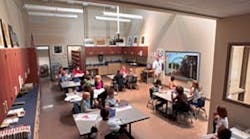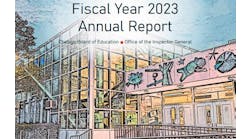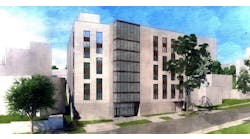For the generation of people whose classroom memories consist of chalk squeaking on a blackboard, weather-beaten textbooks and a ready supply of sharpened No. 2 pencils, the resources available to students in many 21st-century American schools may seem unfamiliar, even amazing.
Computer networks with access to the Internet — wired or wireless — have become commonplace. Instead of a chalkboard or its less dusty successor, the dry-erase board, many classrooms have interactive whiteboards that connect to computers and enable a teacher to project class notes, World Wide Web pages and other data that can be revised on the screen and saved for later review by students.
Many schools provide students with access to online versions of textbooks to supplement or replace the printed versions. One district in Arizona even provides wireless Internet access on one of its school buses so students can make more productive use of their long commutes.
Any one of these innovations would seem astounding to someone transported to the present day from 25 or 30 years ago, when the personal computer was just beginning to turn up in some U.S. classrooms.
But for those eager for a more fundamental transformation of the nation's education system, including the U.S. Department of Education under Secretary Arne Duncan, such innovations represent just a dip of the toe in the ocean of technology.
A draft of The National Education Technology Plan 2010, released in March by the Education Department envisions America's schools totally immersed in technological advances that will produce better prepared students, more effective teaching, more authentic assessments of student performance, more accessible learning resources and more productive school systems.
"Technology provides access to more learning resources than are available in the classroom and connections to a wider set of 'educators,' including teachers, parents, experts and mentors outside the classroom," the plan states.
Opening the Gates
Although the education system as a whole must make great strides to begin to tap the full potential of technology, many schools and universities can point to their efforts in using technological resources to enhance learning opportunities for students.
At the Massachusetts Institute of Technology in Cambridge, the OpenCourseWare project (OCW) provides unrestricted Internet access to educational materials — lecture notes, course calendars, exams, reading lists and some video lectures from more than 1,900 MIT courses.
The first courses went online in 2002, and since then, the school has had more than 91 million visits to OCW (http://mit.ocw.edu) from more than 65 million visitors — representing nearly every nation in the world. Forty-three percent of the users are identified as self-learners; another 42 percent are students; and 9 percent are educators.
The ability to transmit video over the Internet has enabled schools to expand distance-learning opportunities. Electronic or virtual field trips remove geographical barriers and can provide students with interactive experiences and access to resources that would otherwise not be available or affordable.
Last month, fifth-grade students at Westwood View Elementary School in Westwood, Kan., took part in an electronic field trip to Colonial Williamsburg, more than 1,100 miles away in Williamsburg, Va. After watching a broadcast of "The Rights of Youth," several students became part of the presentation via webcam by presenting summaries of what they had been studying about the Revolutionary Era.
Inviting Interaction
Education reformers seek to make learning more focused on students rather than teachers. Technology can help create opportunities for students to take a more active role in their learning.
Interactive whiteboards have become a way for educators to commingle the rich resources found on the Internet with content generated in the classroom and project it to all students or save it as a computer file for later viewing. Depending on the system, users can add content to a touch-sensitive whiteboard with their fingers or with a stylus or pen.
Student-response systems, known more familiarly as "clickers," enable students to provide immediate feedback to instructors about subject matter. Teachers can quickly determine through student responses how well the class is comprehending a lesson and help instructors devise ways to adjust teaching strategies and content to make a lesson more effective.
The clickers resemble remote-control devices. Instructors display questions via a computer projection to a class of students, and the students enter their answers on the clickers. At the University of Iowa, "clickers have been used extensively to review for quizzes and tests, to direct classroom discussions, and to provide feedback on course material," says the university's information technology services department.
Getting the Word Out
Streaming audio over the Internet makes it possible to transmit programs to audiences without the expense of a tower or a broadcast transmitter. With those expensive impediments cleared away, the Houston Independent School District has decided it's going into the radio business.
District officials have announced plans to begin K12RadioHouston, a 24-hour-a-day, seven-days-a-week Internet radio station. When it begins streaming on the Internet in July, its programming will include music, as well as information about programs and activities in the district. Targeting the families of about 200,000 students and 30,000 employees, the district believes its programming will be relevant to about a million potential listeners. The district intends to sell advertising on the station and hopes it will become a revenue generator.
Going Forward
The examples of schools and universities using technology to enhance learning are encouraging, but the National Education Technology Plan 2010 makes it clear that the U.S. education system needs to take better advantage of the technological opportunities that can make learning more appealing to students and improve their academic performance.
The premise at the foundation of the plan is that technology has become inextricably entwined in the lives of most Americans, but the nation's education system has not yet embraced technology to a comparable degree, and because of that, is not reaping the benefits that such innovations can provide.
"The technology of everyday life has moved well beyond what educators regularly use to support student learning," the plan says.
Access to technology in school varies, but away from the school grounds, such access has become an integral part of a student's life: a steady flurry of text messages, frequent status updates on Facebook or other social networking sites, and a reliance on iPods and YouTube videos for entertainment and information.
"Many students' lives outside school are filled with technology that gives them mobile access to information and resources 24/7, enables them to create multimedia content and share it with the world, and allows them to participate in online social networks and communities where people from all over the world share ideas, collaborate and learn new things," the plan says.
At the workplaces where students will arrive after receiving their degrees, a similar reliance on technology — email and instant messages, videoconferencing and broadband Internet connections — has transformed the job descriptions for many employees.
Meanwhile, the goal of maximizing the effectiveness of technology in schools is largely dependent on the funding priorities of states and local districts, and "individual educators' understanding of how to leverage (technology) in learning in meaningful ways," the plans states.
Tear Down Those Walls
In the old model for education, once the afternoon dismissal bell rings, students leave the protective walls of their schoolhouse until the next morning. Their access to learning materials is limited to whatever they are able to haul home in their backpacks. Perhaps a sympathetic sibling or parents with long memories of their school days can step in to help a struggling student, or maybe a trip to the local library is needed.
The Obama administration's technology plan wants those time-based barriers to education removed so that there are no walls preventing students from gaining access to educational resources.
"Our model of an infrastructure for learning is always on, available to students, educators and administrators regardless of their location or the time of day," the plan proposes.
That means universal availability of Internet access.
"Students and educators need Internet access devices for around-the-clock use from any location," the plan says.
And that means schools may have to provide financial help for students who can't afford such devices. "Districts can think about providing an access device and Internet access at home for those students who need them in the same way they provide a free or reduced-price hot lunch for students who could otherwise not afford it," the plan states.
Assessing Progress
Technology can not only enhance a student's learning performance, but also improve a teacher's ability to assess that performance. As education reforms place greater demands on school systems to show improved student performance, it becomes critical for educators to have tools that enable them to evaluate their students accurately.
"An online system can collect much more and much more detailed information about how students are learning than manual methods," the plan says. "As students work, the system can capture their inputs and collect evidence of their problem-solving sequences and strategy use.
Preparing Teachers
The technology plan seeks to bring about a transformation in teaching — from working mostly in isolation to a model of "connected teaching."
"Educators are connected to their students and to professional content, resources, and systems that empower them to create, manage, and assess engaging and relevant learning experiences for students both in and outside school," the plan says. "They also are connected to resources and expertise that improve their own instructional practices and that guide them in becoming facilitators and collaborators in their students' increasingly self-directed learning. In connected teaching, teaching is a team activity."
For the connected teaching model to take hold, reluctant instructors must embrace change and overcome their apprehension about incorporating technology into their jobs.
"Many existing educators do not have the same understanding of and ease with using technology that is part of the daily lives of professionals in other sectors and with this generation of students," the plan says.
Even young teachers who have become accustomed to using technology in their daily lives may not understand how technology can improve their teaching. The technology plan calls for replacing "episodic and ineffective professional development" with professional learning that is "collaborative, coherent, and continuous."
Funding Hurdles
The technology plan's vision for overhauling education is ambitious, especially so in the dire financial situation that so many schools and universities are facing.
Even before the economic difficulties of the last two years, funding for technology was viewed by many educators as inadequate. Results of a survey conducted by the National Center for Education Statistics found that in fall 2008, only 42 percent of school districts believed that their funding for technology was adequate; 47 percent indicated that it was not adequate.
Schools and universities may not be able to significantly boost their funding for technology in the short term, but the plan calls upon education institutions to make wise spending choices.
"More money for education is important, but we must spend education dollars more wisely, starting with being clear about the learning outcomes we expect from the investments we make," the plan asserts. "We also must leverage technology to plan, manage, monitor, and report spending so that we can provide decision-makers with a reliable, accurate, and complete view of the financial performance of our education system at all levels. Such visibility is essential to improving productivity and accountability."
- Read the "Ambitious Goals" sidebar to learn about the National Education Technology Plan 2010's goals.
- Read the "Look Ma, No Books" sidebar to learn about Empire Hich School in the Vail (Ariz.) school district is doing.
- Read the "Infrastructure in Place" sidebar to learn what educational technology was available in U.S. public schools in fall 2008.
Kennedy, staff writer, can be reached at [email protected].
Related Stories
Ambitious Goals
The National Education Technology Plan 2010 sets out five goals for the U.S. education system to pursue as it takes greater advantage of the latest advances:
-
Learning
All learners will have engaging and empowering learning experiences both in and outside of school that prepare them to be active, creative, knowledgeable and ethical participants in our globally networked society.
-
Assessment
Our education system at all levels will leverage the power of technology to measure what matters and use assessment data for continuous improvement.
-
Teaching
Professional educators will be supported individually and in teams by technology that connects them to data, content, resources, expertise and learning experiences that enable and inspire more effective teaching for all learners.
-
Infrastructure
All students and educators will have access to a comprehensive infrastructure for learning when and where they need it.
-
Productivity
Our education system at all levels will redesign processes and structures to take advantage of the power of technology to improve learning outcomes while making more efficient use of time, money and staff.
Look Ma, No Books
At Empire High School in the Vail (Ariz.) district, each student gets a laptop computer instead of textbooks. The school, which opened in 2005, boasts that it is the "first one-to-one laptop, textbook-free, comprehensive public high school in the nation."
The school sees its use of digital content as an educational tool; the technology itself is not the focus of the education.
"It is the mission of Empire High School for students to become self-directed learners," says the school's website.
Classrooms are equipped with ceiling-mounted digital projectors and have tables instead of desks so that students have ample room for their laptops and paperwork.
Earlier this school year, the Vail district extended the reach of technology for some students by installing wireless Internet access on one of its buses so that students could use their long commutes to continue their studies … or at least be able to surf the Web instead of getting into mischief.
Infrastructure in Place
Here's what educational technology was available is U.S. public schools in fall 2008:
| School districts with local-area networks in all schools | 97% |
| School districts with district-level networks in all schools | 81% |
| School districts that provide server space for all elementary teachers to create Web pages or post class materials | 82% |
| School districts that provide server space for all secondary teachers to create web pages or post class materials | 83% |
| School districts that provide all elementary and secondary teachers access to online resources | 92% |
| School districts that provide all elementary teachers remote access to school or district software | 44% |
| School districts that provide all secondary teachers remote access to school or district software | 46% |
| School districts that offer all elementary teachers access to electronic administrative tools | 87% |
| School districts that offer all secondary teachers access to electronic administrative tools | 95% |
| School districts that provide all elementary students with e-mail accounts for schoolwork | 11% |
| School districts that provide all secondary students with e-mail accounts for schoolwork | 28% |
| School districts that provide all elementary students with online access to databases | 60% |
| School districts that provide all secondary students with online access to databases | 68% |
| School districts that offer all elementary students access to online curricula | 47% |
| School districts that offer all secondary students access to online curricula | 53% |
| School districts that offer all elementary students access to distance learning | 30% |
| School districts that offer all secondary students access to distance learning | 46% |
| School districts that have an employee whose full-time responsibility is educational technology leadership | 51% |
| School districts that offer professional development in integrating technology into instruction | 95% |
| School districts that require professional development in integrating technology into instruction | 39% |
| Source: National Center for Education Statistics, "Educational Technology in Public School Districts: Fall 2008" | |



